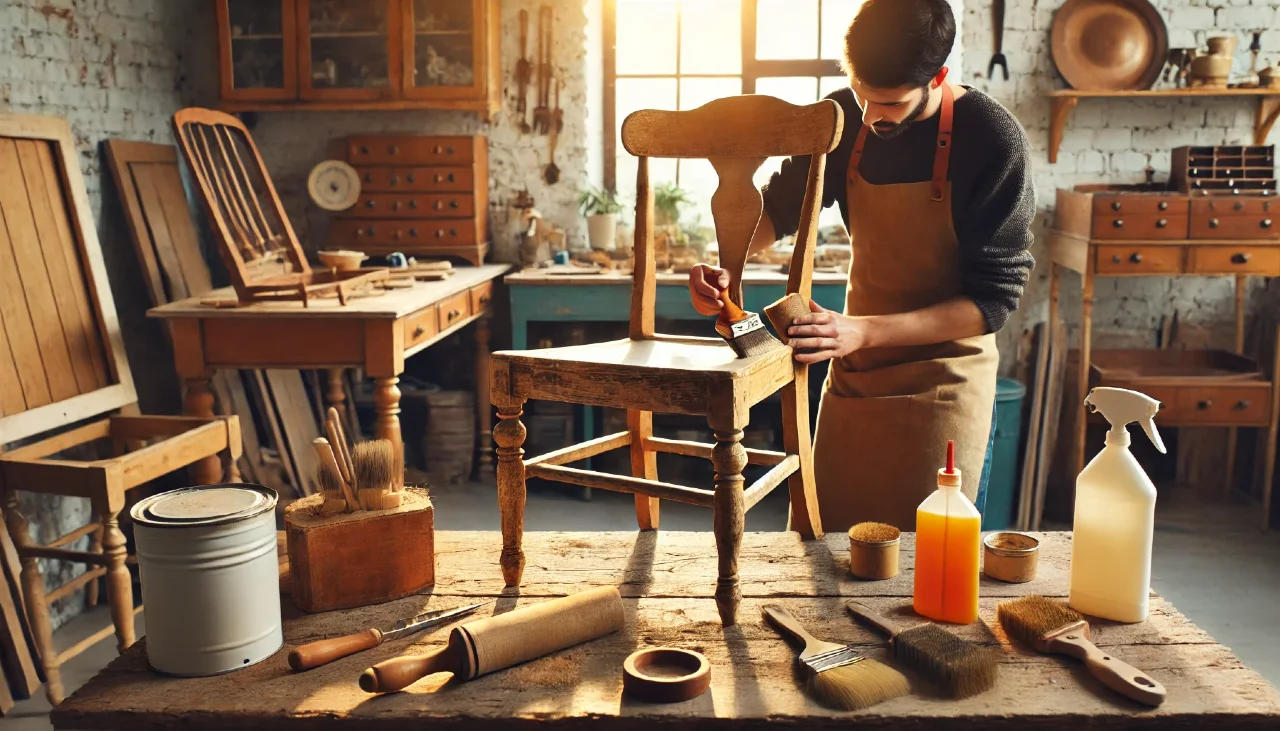Restoring antique furniture is a skill that can breathe new life into old, valuable pieces. Whether you’ve inherited a family heirloom or found a vintage item at a flea market, learning how to restore it properly will help preserve its beauty and functionality. This beginner’s guide covers essential antique furniture restoration tips, from preparation and tools to specific techniques for repairing, cleaning, and refinishing.
Why Restore Antique Furniture?
Restoring antique furniture offers numerous benefits. Not only does it enhance the aesthetic appeal and functionality of old pieces, but it also helps preserve the history and craftsmanship behind each piece. Proper restoration can:
- Extend the life of furniture, ensuring it remains a functional part of your home for generations.
- Maintain or increase value, especially when done with care to preserve the original craftsmanship.
- Help reduce waste and embrace sustainability by giving old furniture a new purpose instead of buying new pieces.
1. Identifying Antique Furniture
Before starting any restoration work, it’s crucial to verify if the piece is genuinely antique. Items over 100 years old are typically considered antique. Some indicators of antique furniture include:
- Joinery: Hand-cut dovetail joints or wooden pegs instead of modern nails or screws suggest a piece is antique.
- Wood type: Antique furniture often uses high-quality hardwoods such as mahogany, oak, walnut, or cherry.
- Patina: A naturally aged wood surface, often darker in color due to exposure to light and air, can indicate the piece’s age.
- Tool marks: Look for irregular tool marks, which suggest the furniture was crafted by hand rather than with modern machinery.
For expensive or significant pieces, it’s wise to consult a professional appraiser to determine authenticity and potential value.
2. Beginner Guide to Restoring Furniture
Restoring antique furniture requires patience, the right tools, and knowledge of how to clean, repair, and refinish wood surfaces without compromising the integrity of the piece. Below is a step-by-step guide to help beginners restore antique furniture:
2.1. Preparation
Before you begin any restoration work, gather the necessary tools and plan out your approach. Preparation is key to ensuring the restoration goes smoothly and without damaging the furniture.
Tools Needed for Antique Furniture Restoration
- Screwdrivers: For disassembling parts of the furniture (e.g., hinges, handles).
- Rubber mallet: To gently separate joints without damaging wood.
- Sandpaper: For smoothing out surfaces (start with 180-grit and move to finer grit as needed).
- Chemical paint stripper: To remove old layers of paint or varnish.
- Wood glue and clamps: Essential for repairing broken joints and cracks.
- Furniture wax or oil: For polishing and preserving the finish.
- Natural fiber brushes: For applying waxes, oils, and varnishes.
Safety Considerations
When restoring antique furniture, safety is paramount. Ensure that:
- You work in a well-ventilated area to avoid inhaling fumes from chemicals.
- Wear gloves, goggles, and a dust mask when using paint strippers, sanding, or applying finishes.
- Keep your workspace tidy and organized to prevent accidents.
2.2. Cleaning Antique Furniture
The first step in restoring antique furniture is cleaning the surface to remove dirt, grime, and dust accumulated over the years.
How to Clean Antique Furniture
- Start with gentle cleaners: Mix mild dish soap with water and dampen a soft cloth to wipe down the furniture. Avoid soaking the wood, and dry it immediately with a clean cloth.
- Use a toothbrush for details: For intricate carvings or tight spaces, use a soft toothbrush to gently clean out the grime.
- Avoid abrasive cleaners: Harsh chemicals can strip away the natural patina and damage the wood.
Removing Stains from Antique Wood
Over the years, furniture can accumulate stains from oil, water, or ink. Here’s how to tackle these common issues:
- Oil stains: Apply talcum powder or baking soda to the stain to absorb the oil. For deeper stains, use fine steel wool and mineral spirits to gently remove the residue.
- Water stains: Use a mixture of baking soda and water to create a paste and gently rub it onto the water stain. Alternatively, place a cloth over the stain and press it with a warm iron.
- Ink stains: Carefully rub fine sandpaper or steel wool over the stain. Be gentle to avoid damaging the wood underneath.
2.3. Repairing Damaged Antique Furniture
After cleaning, assess the structural integrity of the furniture. This step involves repairing cracks, replacing missing pieces, and strengthening joints.
How to Fix Antique Furniture Cracks
- Wood filler: For small cracks, apply wood filler using a putty knife. Allow it to dry completely before sanding the area smooth.
- Wood glue: For larger cracks or loose joints, use wood glue and clamps to hold the piece in place while the glue dries.
Repairing Damaged Veneer
Many antique pieces are covered with thin layers of wood veneer, which can peel or chip over time.
- Re-glue peeling veneer: Gently lift the loose veneer, apply wood glue underneath, and use a clamp to hold it in place until it dries.
- Patch missing veneer: If a section of veneer is missing, cut a new piece to match, apply glue, and fit it in place. Sand the edges to ensure a smooth transition.
2.4. Stripping Paint from Old Furniture
In some cases, you’ll need to strip old paint or varnish to restore the natural beauty of the wood. This process must be done carefully to avoid damaging the wood.
Stripping Paint from Old Furniture
- Apply paint stripper: Use a paintbrush to apply a chemical paint stripper to the surface of the furniture. Follow the manufacturer’s instructions regarding application time.
- Scrape the paint: After the paint softens, use a plastic or metal scraper to remove it. Be careful not to gouge the wood beneath.
- Neutralize the stripper: Once the paint is removed, clean the surface with mineral spirits or water, depending on the stripper used, to neutralize the chemicals.
2.5. Sanding Antique Furniture Safely
Once the paint or varnish is removed, sanding the surface smooths out imperfections and prepares the wood for finishing.
Sanding Tips
- Start with coarse sandpaper (180-grit) and work your way to finer grits (220- to 320-grit) to achieve a smooth finish.
- Always sand with the grain to avoid creating scratches on the wood.
- Be gentle around carvings and details to avoid sanding away intricate designs.
3. Refinishing Antique Wood Furniture
Refinishing is one of the most transformative parts of the restoration process. It involves applying new finishes like varnish, oil, or wax to protect the wood and enhance its appearance.
How to Refinish Antique Wood Furniture
- Choose the right finish: Options include shellac, lacquer, polyurethane, or natural oils. Consider the type of wood and the desired appearance.
- Apply the finish: Use a clean brush or cloth to apply the finish in long, even strokes. Allow each coat to dry fully before sanding lightly and applying additional layers.
- Buff and polish: After the final coat has dried, buff the surface with a soft cloth to achieve a smooth, polished finish.
Best Products for Restoring Furniture
Choosing the right products can make a significant difference in the restoration process:
- Beeswax or carnauba wax: Ideal for maintaining the wood’s natural patina.
- Tung oil: A popular natural finish that penetrates deep into the wood, offering long-lasting protection.
- Shellac: Provides a glossy, durable finish often used in antique restoration.
4. Upholstery Tips for Antique Furniture
In addition to wood restoration, many antique pieces have upholstered components that require attention.
Reupholstering Antique Furniture
- Remove old fabric: Carefully remove the old upholstery, noting how it was attached. Take care not to damage the wood frame.
- Replace padding: Old padding often needs replacing. Choose high-quality materials that match the original look and feel.
- Attach new fabric: Use a staple gun or upholstery tacks to secure the new fabric in place, ensuring it’s pulled tight and evenly distributed.
5. Preserving the Patina
One of the most important aspects of restoring antique furniture is preserving the patina—the natural aging and coloration of the wood that develops over time. The patina adds character and can increase the piece’s value.
How to Preserve Antique Furniture Finish
To maintain the original finish:
- Avoid over-sanding: Only sand as much as necessary to smooth the surface.
- Use gentle cleaners: Harsh chemicals can strip away the patina and damage the wood.
- Polish regularly: Applying a natural wax or oil will help protect the finish without altering the appearance.
6. Restoring Antique Hardware
In addition to restoring wood and upholstery, antique furniture often features unique hardware like knobs, hinges, or drawer pulls that need restoration.
How to Restore Old Furniture Hardware
- Soak in vinegar: For metal hardware, soak it in white vinegar to remove rust and grime.
- Polish the hardware: Use metal polish to restore the shine and protect against future corrosion.
If the hardware is missing or too damaged to restore, consider purchasing antique reproduction hardware to match the original design.
6. Restoring Antique Hardware
In addition to restoring the wood and upholstery, antique furniture often features distinctive hardware, such as brass or iron knobs, hinges, or drawer pulls. These elements can tarnish or corrode over time, diminishing the piece’s aesthetic and functionality. Here are steps on how to restore antique hardware effectively.
How to Restore Old Furniture Hardware
- Soak in Vinegar: To clean old hardware, soak it in white vinegar for 10-15 minutes to loosen rust and dirt. For more stubborn corrosion, leave it overnight.
- Scrub Gently: Use a soft-bristle brush or fine steel wool to scrub away tarnish and rust. Be gentle to avoid scratching delicate or ornamental details.
- Polish the Hardware: Apply metal polish or a paste made of baking soda and water to restore the hardware’s shine. Buff with a soft cloth for a smooth finish.
If original hardware is missing or beyond repair, you can purchase reproduction hardware to match the period and style of the piece.
7. Finishing and Protecting Restored Furniture
Once you’ve repaired and refinished your antique furniture, preserving the finish is crucial for protecting the piece from further damage. Different finishes offer varying levels of protection, from water-resistant varnishes to natural oils and waxes that nourish the wood.
Best Wax for Antique Wood
One of the most effective ways to protect and maintain antique wood furniture is by applying a protective layer of wax. Wax offers a soft sheen, protects the finish, and enhances the wood’s natural beauty.
- Beeswax: This natural wax is commonly used for its soft, smooth finish that protects without creating a shiny surface.
- Carnauba Wax: A harder, more durable wax that provides a glossy, protective coating. It’s particularly useful for high-traffic furniture.
- Application: Apply a thin layer of wax with a soft cloth, rubbing it into the grain. After it dries, buff the surface with a clean cloth to achieve a smooth, polished finish.
Polishing Antique Wood Furniture
Regular polishing is key to maintaining the beauty and durability of restored antique furniture. Use a natural wood polish, such as lemon oil, or a specialized furniture polish that’s safe for antique pieces. Polishing helps protect the finish from dust and moisture while enhancing the wood’s natural patina.
8. Maintaining Restored Antique Furniture
Once your restoration project is complete, maintaining the piece properly is crucial to ensuring its longevity. Here are some tips to keep your antique furniture looking its best.
How to Maintain Restored Furniture
- Dust regularly: Use a soft, lint-free cloth to dust the furniture, as dust can scratch the surface over time.
- Avoid direct sunlight: Sunlight can cause wood to fade or crack. Place your restored piece away from windows or use UV-protective curtains.
- Regulate humidity: Antique wood can warp or crack in fluctuating humidity levels. Keep the room at a stable humidity level, ideally between 40-50%, to protect the wood.
- Handle with care: When moving antique furniture, always lift it instead of dragging it to prevent stress on joints and legs.
9. Beginner Mistakes to Avoid in Furniture Restoration
As a beginner, it’s easy to make mistakes during your first furniture restoration projects. Avoid these common pitfalls to ensure your restoration is successful and preserves the integrity of the piece.
Common Mistakes in Restoring Antique Furniture
- Over-sanding: Sanding too aggressively can strip away the patina or thin out wood veneers, reducing the antique’s value.
- Using harsh chemicals: Strong chemicals can damage wood and finishes. Always use products specifically designed for antique furniture, or opt for natural cleaning methods.
- Skipping the research: Each piece of furniture may have unique requirements based on its age, wood type, and finish. Researching these factors before you begin restoration can save you from making irreversible mistakes.
10. Restoring Antique Furniture for Beginners: Key Takeaways
Restoring antique furniture is a rewarding project that not only revitalizes a piece but also preserves a part of history. By following the proper steps—identifying the piece, cleaning, repairing, stripping, refinishing, and preserving—you can bring old furniture back to life while maintaining its beauty and value. Keep in mind the following tips as you embark on your restoration journey:
- Start with gentle cleaning methods and escalate only if necessary.
- Be patient and take your time with each step of the restoration process.
- Always use high-quality materials and tools to achieve the best results.
By restoring your furniture carefully, you’ll create a beautiful, functional piece that will last for many more years.
Conclusion
Restoring antique furniture may seem daunting at first, but with the right tools, knowledge, and patience, even beginners can achieve remarkable results. Whether you’re restoring vintage furniture, fixing damaged veneer, or learning to clean and polish delicate wood, each step brings you closer to preserving a piece of history. Keep practicing, and soon you’ll master the art of antique furniture restoration.
This comprehensive guide provides you with the essential steps and tips to successfully restore antique furniture and enjoy the satisfaction of bringing an old piece back to life!




